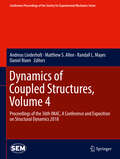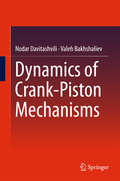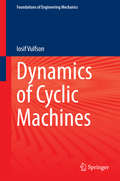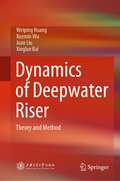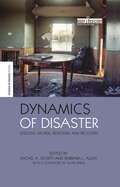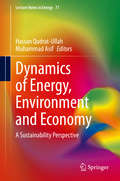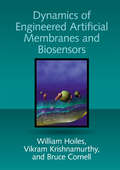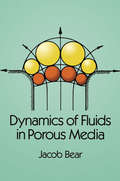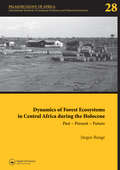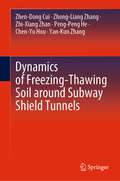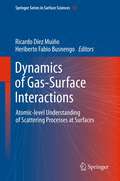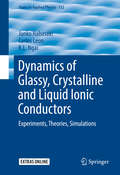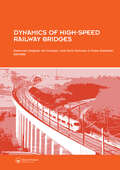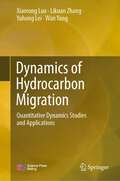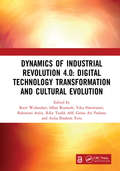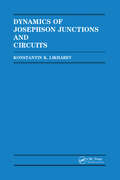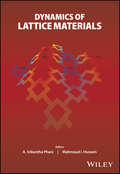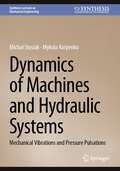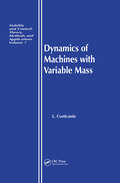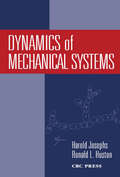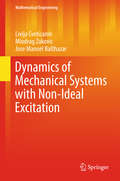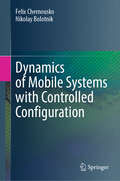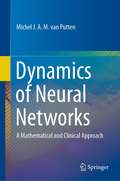- Table View
- List View
Dynamics of Coupled Structures, Volume 4: Proceedings Of The 35th Imac, A Conference And Exposition On Structural Dynamics 2017 (Conference Proceedings of the Society for Experimental Mechanics Series)
by Randall L. Mayes Daniel Rixen Matthew S. Allen Andreas LinderholtDynamics of Coupled Structures, Volume 4: Proceedings of the 36th IMAC, A Conference and Exposition on Structural Dynamics, 2018, the fourth volume of nine from the Conference brings together contributions to this important area of research and engineering. The collection presents early findings and case studies on fundamental and applied aspects of the Dynamics of Coupled Structures, including papers on: Experimental Nonlinear DynamicsJoints, Friction & DampingNonlinear SubstructuringTransfer Path Analysis and Source CharacterizationAnalytical Substructuring & Numerical Reduction TechniquesReal Time SubstructuringAssembling & Decoupling Substructures & Boundary Conditions
Dynamics of Crank-Piston Mechanisms
by Nodar Davitashvili Valeh BakhshalievThis monograph focuses on the dynamical researchwork on crank-piston mechanisms considering basic and additional motions. Inorder to have full dynamical analyses of piston machines and their mechanisms, thebook studies the crank-piston mechanisms with clearances in kinematic pairs. The tasks are carried out by focusing on friction, wear and impacts inmechanisms, as well as cracks formation in links and elasticity of details,with distributed and concentrated masses. Then, the reliability and durability ofthe mechanisms of piston machines is applied on oil and gas transportation. The monograph is meant for design specialists. It is also useful for specialists-manufacturers and designers of pistonmachines, scientists and lecturers, doctoral students.
Dynamics of Cyclic Machines
by Iosif VulfsonThis book focuses on the methods of dynamic analysis and synthesis of machines, comprising of cyclic action mechanisms, such as linkages, cams, steppers, etc. It presents the modern methods of oscillation analysis in machines, including cyclic action mechanisms (linkage, cam, stepper, etc. ). Thus, it builds a bridge between the classic theory of oscillations and its practical application in the dynamic problems for cyclic machines. The author take into account that, in the process of training engineers for jobs in engineering industries, producing cyclic machines, insufficient attention is paid, until now, to the problems of dynamic and especially to oscillations.
Dynamics of Deepwater Riser: Theory and Method
by Weiping Huang Xuemin Wu Juan Liu Xinglan BaiThis book demonstrates various types of deepwater risers with different motion equations and boundary conditions depending on their different structural configurations. It also discusses the hydrodynamic analysis methods of different deepwater risers. It provides new force and structure models in time and frequency domains of vortex induced force, including that for a downstream riser of the tandem riser, and the rigid oscillating model for steel catenary riser. The highlights of this book are the analysis methods of the rigid oscillating mode of steel catenary riser and the coupling iteration for top-tensioned riser with pipe-in-pipe configuration. This book is interesting and useful to a wide readership in the various fields of ocean engineering and offshore oil & gas development.
Dynamics of Disaster: Lessons on Risk, Response and Recovery (The Earthscan Science in Society Series)
by Rachel A. Dowty Barbara L. AllenDisasters are the result of complex interactions between social and natural forces, acting at multiple scales from the individual and community to the organisational, national and international level. Effective disaster planning, response and recovery require an understanding of these interacting forces, and the role of power, knowledge and organizations. This book sheds new light on these dynamics, and gives disaster scholars and practitioners new and valuable lessons for management and planning in practice. The authors draw on methods across the social sciences to examine disaster response and recovery as viewed by those in positions of authority and the 'recipients' of operations. These first two sections examine cases from Hurricane Katrina, while the third part compares this to other international disasters to draw out general lessons and practical applications for disaster planning in any context. The authors also offer guidance for shaping institutional structures to better meet the needs of communities and residents.
Dynamics of Energy, Environment and Economy: A Sustainability Perspective (Lecture Notes in Energy #77)
by Muhammad Asif Hassan Qudrat-UllahThe book addresses the vital and interwoven areas of energy, environment, and the economy within the field of sustainability research. Fundamental technical details, empirical data, and case studies taking into account local and international perspectives are included. Issues such as energy security, depleting fossil fuel reserves, global warming and climate change, as well as novel energy technologies are covered. The dynamic global response will be discussed from the perspective of policy, technology, and economics.Vital details in the form of text boxes, illustrations, graphs, tables and appendices are included. The book will serve as reference book for upper-level undergraduate and graduate students, researchers, academics, policy makers, NGOs and developmental sector professionals within the field.
Dynamics of Engineered Artificial Membranes and Biosensors
by Vikram Krishnamurthy William Hoiles Bruce CornellLearn about the state of the art in building artificial membranes and synthetic biological devices, and in constructing mathematical models for their dynamics at multiple time and spatial scales with this comprehensive book. <P><P>Drawing on recent advances in bioengineering and biochemistry, it describes how to engineer tethered bilayer lipid membranes, bioelectronic interfaces, high-resolution biosensors, and diagnostic devices for non-invasive cellular measurements and electroporation. Multi-physics models combining atomistic (molecular dynamics and coarse-grained molecular dynamics), mesoscopic (Poisson–Nernst–Planck), and macroscopic (reaction-rate theory) dynamics provide a complete structure-to-function description of these devices. Experiments and dynamic models explain how anti-microbial peptides penetrate membranes, how molecular machine biosensors built out of artificial membranes can detect femtomolar concentrations, and how electroporation can be controlled. Supported by atomistic simulation code online, this is essential reading for researchers, students and professionals in bioengineering, chemical engineering, biophysics, applied mathematics, and electrical engineering.<P> The first book to provide a comprehensive treatment of artificial membranes: their design, construction, experimental studies, and mathematical models.<P> Includes an introduction to membrane biology and biochemistry.<P> Addresses building and modelling the bioelectronic interface, which is crucial for synthetic biological devices.
Dynamics of Fluids in Porous Media (Dover Civil and Mechanical Engineering)
by Jacob BearThis classic work by one of the world's foremost hydrologists presents a topic encountered in the many fields of science and engineering where flow through porous media plays a fundamental role. It is the standard work in the field, designed primarily for advanced undergraduate and graduate students of ground water hydrology, soil mechanics, soil physics, drainage and irrigation engineering, and petroleum and chemical engineering. It is highly recommended as well for scientists and engineers already working in these fields.Throughout this generously illustrated, richly detailed study, which includes a valuable section of exercises and answers, the emphasis is on understanding the phenomena occurring in porous media and on their macroscopic description. The book's chapter titles reveal its comprehensive coverage: Introduction, Fluids and Porous Matrix Properties, Pressures and Piezometric Head, The Fundamental Fluid Transport Equations in Porous Media, The Equation of Motion of a Homogeneous Fluid, Continuity and Conservation Equations for a Homogeneous Fluid, Solving Boundary and Initial Value Problems, Unconfined Flow and the Dupuit Approximation, Flow of Immiscible Fluids, Hydrodynamic Dispersion, and Models and Analogs."Systematic and comprehensive . . . a book that satisfies the highest standards of excellence. . . . Will undoubtedly become the standard reference in this field." — R. Allen Freeze, IBM Thomas J. Watson Research Center, Water Resources Research.
Dynamics of Forest Ecosystems in Central Africa During the Holocene: Palaeoecology of Africa, An International Yearbook of Landscape Evolution and Palaeoenvironments, Volume 28 (Palaeoecology of Africa)
by Jürgen RungeBringing together experts from several disciplines, this volume collects the best papers presented at the international workshop on 'Environmental and Cultural Change in West and Central Africa, held in Cameroon, March 2006. Problems of Holocene and Late Pleistocene modifications of the rain forest savanna fringe and their possible influence on cultural innovations are discussed. This is an important resource for those concerned with tropical forests and related development problems of third world countries. It is an excellent source of information for new original manuscripts on the topic of Late Pleistocene and Holocene landscape evolution in the lower latitudes of Africa.
Dynamics of Freezing-Thawing Soil around Subway Shield Tunnels
by Zhen-Dong Cui Zhong-Liang Zhang Zhi-Xiang Zhan Peng-Peng He Chen-Yu Hou Yan-Kun ZhangThis book addresses development laws for axial strain and excess pore water pressure in silty clay around subway shield tunnels before and after freezing-thawing when subjected to subway loading, as well as the effect of freezing-thawing on the dynamic parameters of silty clay, including the dynamic modulus and damping ratio, introducing readers to the design and construction of bypasses in subway tunnels with the artificial freezing method. On this basis, it then studies the microstructures of silty clay before and after freezing-thawing cyclic loading by means of scanning electron microscope tests and mercury intrusion porosimetry tests. Lastly, the book presents a numerical simulation of the dynamics of silty clay around subway tunnels before and after thawing. Given its scope, it offers a valuable reference guide for construction researchers and designers alike, as well as senior undergraduate and graduate students at colleges and universities.
Dynamics of Gas-Surface Interactions
by Ricardo Diez Muino Heriberto Fabio BusnengoThis book gives a representative survey of the state of the art of research on gas-surface interactions. It provides an overview of the current understanding of gas surface dynamics and, in particular, of the reactive and non-reactive processes of atoms and small molecules at surfaces. Leading scientists in the field, both from the theoretical and the experimental sides, write in this book about their most recent advances. Surface science grew as an interdisciplinary research area over the last decades, mostly because of new experimental technologies (ultra-high vacuum, for instance), as well as because of a novel paradigm, the 'surface science' approach. The book describes the second transformation which is now taking place pushed by the availability of powerful quantum-mechanical theoretical methods implemented numerically. In the book, experiment and theory progress hand in hand with an unprecedented degree of accuracy and control. The book presents how modern surface science targets the atomic-level understanding of physical and chemical processes at surfaces, with particular emphasis on dynamical aspects. This book is a reference in the field.
Dynamics of Glassy, Crystalline and Liquid Ionic Conductors
by K. L. Ngai Junko Habasaki Carlos LeonThis book discusses the physics of the dynamics of ions in various ionically conducting materials, and applications including electrical energy generation and storage. The experimental techniques for measurements and characterization, molecular dynamics simulations, the theories of ion dynamics, and applications are all addressed by the authors, who are experts in their fields. The experimental techniques of measurement and characterization of dynamics of ions in glassy, crystalline, and liquid ionic conductors are introduced with the dual purpose of introducing the reader to the experimental activities of the field, and preparing the reader to understand the physical quantities derived from experiments. These experimental techniques include calorimetry, conductivity relaxation, nuclear magnetic resonance, light scattering, neutron scattering, and others. Methods of molecular dynamics simulations are introduced to teach the reader to utilize the technique for practical applications to specific problems. The results elucidate the dynamics of ions on some issues that are not accessible by experiments. The properties of ion dynamics in glassy, crystalline and liquid ionic conductors brought forth by experiments and simulations are shown to be universal, i. e. independent of physical and chemical structure of the ionic conductor as long as ion-ion interaction is the dominant factor. Moreover these universal properties of ion dynamics are shown to be isomorphic to other complex interacting systems including the large class of glass-forming materials with or without ionic conductivity. By covering the basic concepts, theories/models, experimental techniques and data, molecular dynamics simulations, and relating them together, Dynamics of Glassy, Crystalline and Liquid Ionic Conductors will be of great interest to many in basic and applied research areas from the broad and diverse communities of condensed matter physicists, chemists, materials scientists and engineers. The book also provides the fundamentals for an introduction to the field and it is written in such a way that can be used for teaching courses either at the undergraduate or graduate level in academic institutions.
Dynamics of High-Speed Railway Bridges: Selected and revised papers from the Advanced Course on 'Dynamics of High-Speed Railway Bridges' Porto, Portugal, 20-23 September 2005
by Rui Calçada Raimundo Delgado José Maria Goicolea Felipe GabaldónThe dynamic behaviour of bridges strongly affects the infrastructure system of high-speed railways, and is a crucial factor in safety issues and passenger comfort. Dynamics of High-Speed Railway Bridges covers the latest research in this field, including: � Recently developed dynamic analysis techniques; � Train excitations;� Design issues fo
Dynamics of Hydrocarbon Migration: Quantitative Dynamics Studies and Applications
by Xiaorong Luo Likuan Zhang Yuhong Lei Wan YangThis book presents the authors' research findings on the dynamics of oil migration, research methodologies, insights and applications in petroliferous basins. It studies the behaviors of oil migration in porous media through physical experiments and numerical simulations, explores the mechanism of oil migration and effects of migration process, and then establishes a migration modeling method by coupling the source, driving forces and carriers. The new method can be used to estimate the amount of migrated hydrocarbons and then predict the location of possible hydrocarbon accumulations in different parts of a basin. This approach is useful for resources assessment and prediction of the distribution of hydrocarbon accumulations. An example utilizing this methodology is presented to study the dynamics of migration and accumulation processes in the southern slope of Dongying Depression in Bohai Bay Basin in China. The book appeals to scientists and professionals working on petroleum prospecting as well as faculty and students in petroleum geology.
Dynamics of Industrial Revolution 4.0: Proceedings of the 7th Bandung Creative Movement International Conference on Creative Industries (7th BCM 2020), Bandung, Indonesia, 12th November 2020
by Ratri WulandariThe 7th Bandung Creative Movement conference presented the theme "Dynamics of Industrial Revolution 4.0" which discussed how the digital world and connectivity changed human culture in various aspects of life, and transformed in accordance to human needs and social culture. Digital technology has transformed society to serve people from manufacturing needs to smart cities, from network connectivity to people connectivity. The application of information technology has helped in improving live quality and environmental sustainability. Digital transformation is revolutionizing how businesses and workers interconnect to be more productive and efficient. The result is improved collaboration, faster processes and time-to-market, lower costs and better products. Devices are getting smarter, meaning they are able to perform more and more tasks without human intervention; moreover, these devices generate data that provide insights to further improve processes and gain greater efficiencies. Moreover, with the Internet of Things (IoT), all these smart devices are interconnected in ways that not only help make them even smarter, but also enhances the intelligence of the overall system. Digital technology is a formidable driver for the transformation of a highly carbon-dependent world into one that is more ecologically ‘smart.’ We are entering a new era of environmental innovation that is driving better alignment between technology and environmental goals. Since its first announcement in 2011, industrial revolution 4.0 has dynamically changed and transformed to adjust itself to the human needs and to serve more efficiency and effectiveness of everyday life as well as environmental enhancement. The 7th Bandung Creative Movement has brought forward discussions on dynamic changes, ups and downs, innovations, relations of industrial revolution of the internet of thing, data, automation, to human physical world, new art and aesthetic, business, product innovation, built environment, and education.
Dynamics of Josephson Junctions and Circuits
by Konstantin K. LikharevThis monograph offers a detailed description of the statistics, dynamics and statics of Josephson junctions. Particular emphasis is placed on the dynamics of new circuits and analog and digital devices using single quanta of magnetic flux.
Dynamics of Lattice Materials
by A. Srikantha Phani Mahmoud I. HusseinProvides a comprehensive introduction to the dynamic response of lattice materials, covering the fundamental theory and applications in engineering practice Offers comprehensive treatment of dynamics of lattice materials and periodic materials in general, including phononic crystals and elastic metamaterials Provides an in depth introduction to elastostatics and elastodynamics of lattice materials Covers advanced topics such as damping, nonlinearity, instability, impact and nanoscale systems Introduces contemporary concepts including pentamodes, local resonance and inertial amplification Includes chapters on fast computation and design optimization tools Topics are introduced using simple systems and generalized to more complex structures with a focus on dispersion characteristics
Dynamics of Machines and Hydraulic Systems: Mechanical Vibrations and Pressure Pulsations (Synthesis Lectures on Mechanical Engineering)
by Mykola Karpenko Michał StosiakThe subject of this book is to examine the influence of mechanical vibration on the changes in the pressure pulsation spectrum of hydraulic systems. In book shows that machines and equipment equipped with hydraulic systems are a source of vibration with a wide frequency spectrum. Additionally, hydraulic valves are also exposed to vibration. Vibrations of the substrate on which the hydraulic valve is installed force the control element of the hydraulic valve to vibrate. The control element's vibration produced in this way causes changes in the pressure pulsation spectrum of the hydraulic system. A friction model modified using mixed friction theory can be used for the oscillating motion of the hydraulic directional control spool. Passive vibration isolation methods are proposed to reduce valve vibration. The biomimetic approach can be implemented in hydraulic systems (for pipelines) to reduce mechanical vibration and fluid pulsation. Numerical methods are employed to analyze the effectof changes in the pressure pulsation spectrum on the hydraulic efficiency of the pipelines. Examples are provided for the implementation of numerical methods in the calculation of hydraulic components and systems. Additionally, the effects of energy-saving in hydraulic systems by applying the proposed results overview in the current book. The current book will be interesting for both–scientific and manufacturing staff, since the implementation of knowledge can help to design more substantiable construction of machine hydraulic systems to avoid vibration problems.
Dynamics of Machines with Variable Mass
by L CveticaninDesigned to be a complete and integrated text on the dynamic properties of machines, mechanisms, and rotors with variable mass, this book presents new results from investigations based on the general dynamics of systems with variable parameters. The book considers both weak and strong nonlinear vibrations of these systems, and chaotic phenomena are also discussed. The conservation laws and adiabatic invariants for systems with variable mass are formulated and the stability and instability conditions of motion are defined.
Dynamics of Mechanical Systems
by Ronald Huston Harold JosephsMechanical systems are becoming increasingly sophisticated and continually require greater precision, improved reliability, and extended life. To meet the demand for advanced mechanisms and systems, present and future engineers must understand not only the fundamental mechanical components, but also the principles of vibrations, stability, and bala
Dynamics of Mechanical Systems with Non-Ideal Excitation
by Livija Cveticanin Miodrag Zukovic Jose Manoel BalthazarIn this book the dynamics of the non-ideal oscillatory system, in which the excitation is influenced by the response of the oscillator, is presented. Linear and nonlinear oscillators with one or more degrees of freedom interacting with one or more energy sources are treated. This concerns for example oscillating systems excited by a deformed elastic connection, systems excited by an unbalanced rotating mass, systems of parametrically excited oscillator and an energy source, frictionally self-excited oscillator and an energy source, energy harvesting system, portal frame – non-ideal source system, non-ideal rotor system, planar mechanism – non-ideal source interaction. For the systems the regular and irregular motions are tested. The effect of self-synchronization, chaos and methods for suppressing chaos in non-ideal systems are considered. In the book various types of motion control are suggested. The most important property of the non-ideal system connected with the jump-like transition from a resonant state to a non-resonant one is discussed. The so called ‘Sommerfeld effect’, resonant unstable state and jumping of the system into a new stable state of motion above the resonant region is explained. A mathematical model of the system is solved analytically and numerically. Approximate analytical solving procedures are developed. Besides, simulation of the motion of the non-ideal system is presented. The obtained results are compared with those for the ideal case. A significant difference is evident. The book aims to present the established results and to expand the literature in non-ideal vibrating systems. A further intention of the book is to give predictions of the effects for a system where the interaction between an oscillator and the energy source exist. The book is targeted at engineers and technicians dealing with the problem of source-machine system, but is also written for PhD students and researchers interested in non-linear and non-ideal problems.
Dynamics of Mobile Systems with Controlled Configuration
by Felix Chernousko Nikolay BolotnikThe book discusses the dynamics and control of motion for mobile robots and other systems capable of moving in various environments by modifying their configurations. It is intended for researchers and engineers in theoretical and applied mechanics, robotics, control theory, and biomechanics. Additionally, graduate and post-graduate students studying these disciplines will find it a useful resource.
Dynamics of Multiphase Flows (Cambridge Series in Chemical Engineering)
by Liang-Shih Fan Chao Zhu Zhao YuUnderstand multiphase flows using multidisciplinary knowledge in physical principles, modelling theories, and engineering practices. This essential text methodically introduces the important concepts, governing mechanisms, and state-of-the-art theories, using numerous real-world applications, examples, and problems. Covers all major types of multiphase flows, including gas-solid, gas-liquid (sprays or bubbling), liquid-solid, and gas-solid-liquid flows. Introduces the volume-time-averaged transport theorems and associated Lagrangian-trajectory modelling and Eulerian-Eulerian multi-fluid modelling. Explains typical computational techniques, measurement methods and four representative subjects of multiphase flow systems. Suitable as a reference for engineering students, researchers, and practitioners, this text explores and applies fundamental theories to the analysis of system performance using a case-based approach.
Dynamics of Neural Networks: A Mathematical and Clinical Approach
by Michel J.A.M. van PuttenThis book treats essentials from neurophysiology (Hodgkin–Huxley equations, synaptic transmission, prototype networks of neurons) and related mathematical concepts (dimensionality reductions, equilibria, bifurcations, limit cycles and phase plane analysis). This is subsequently applied in a clinical context, focusing on EEG generation, ischaemia, epilepsy and neurostimulation. The book is based on a graduate course taught by clinicians and mathematicians at the Institute of Technical Medicine at the University of Twente. Throughout the text, the author presents examples of neurological disorders in relation to applied mathematics to assist in disclosing various fundamental properties of the clinical reality at hand. Exercises are provided at the end of each chapter; answers are included. Basic knowledge of calculus, linear algebra, differential equations and familiarity with MATLAB or Python is assumed. Also, students should have some understanding of essentials of (clinical) neurophysiology, although most concepts are summarized in the first chapters. The audience includes advanced undergraduate or graduate students in Biomedical Engineering, Technical Medicine and Biology. Applied mathematicians may find pleasure in learning about the neurophysiology and clinic essentials applications. In addition, clinicians with an interest in dynamics of neural networks may find this book useful, too.
Dynamics of Non-Spherical Particles in Turbulence (Springer Theses)
by Luis Blay EstebanThis book studies the dynamics of 2D objects moving through turbulent fluids. It examines the decay of turbulence over extended time scales, and compares the dynamics of non-spherical particles moving through still and turbulent fluids. The book begins with an introduction to the project, its aims, and its relevance for industrial applications. It then discusses the movement of planar particles in quiescent fluid, and presents the numerous methodologies used to measure it. The book also presents a detailed analysis of the falling style of irregular particles, which makes it possible to estimate particle trajectory and wake morphology based on frontal geometry. In turn, the book provides the results of an analysis of physically constrained decaying turbulence in a laboratory setting. These results suggest that large-scale cut-off in numerical simulations can result in severe bias in the computed turbulent kinetic energy for long waiting times. Combining the main text with a wealth of figures and sketches throughout, the book offers an accessible guide for all engineering students with a basic grasp of fluid mechanics, while the key findings will also be of interest to senior researchers.
